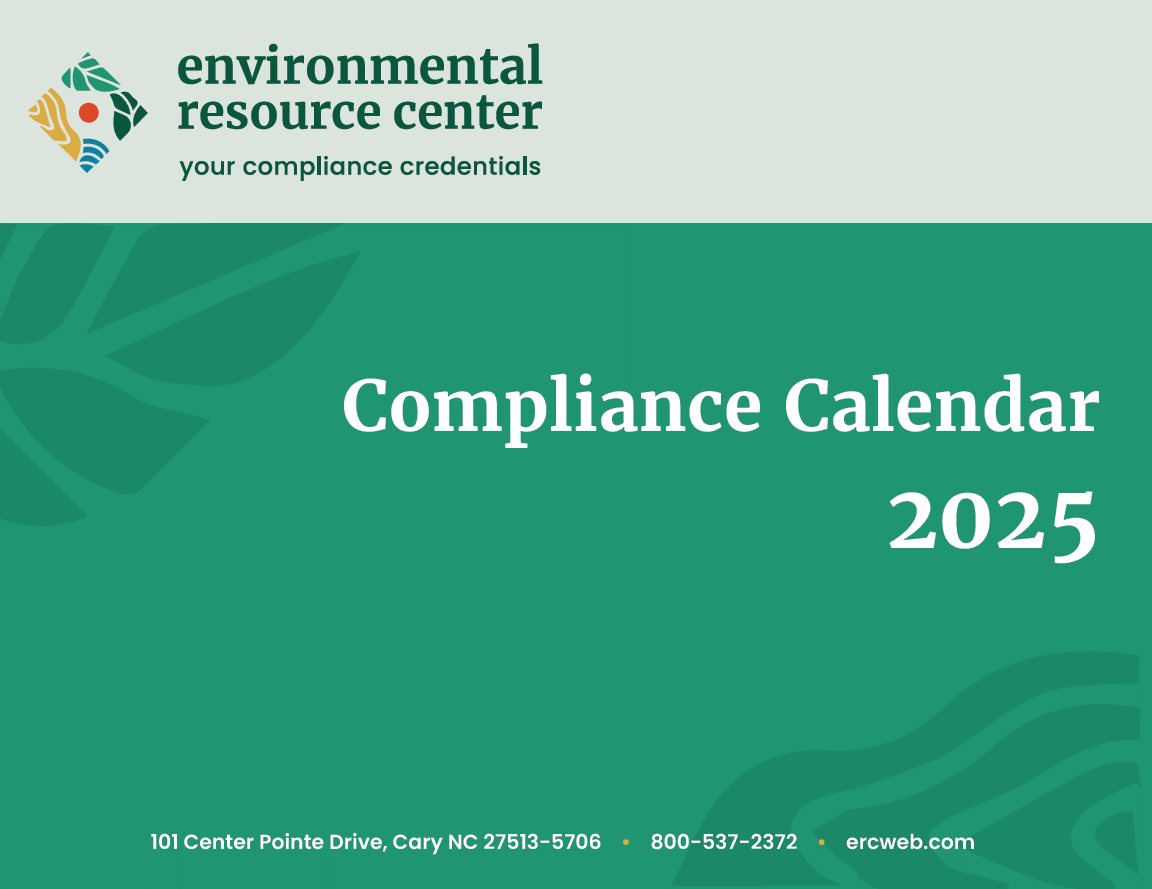 OSHA is increasing its penalties to meet the Federal Civil Penalties Inflation Adjustment Act Improvements Act of 2015. A draft of a Federal Register notice, which will be probably be published after the conclusion of the shutdown listed the new maximum penalties as:
OSHA is increasing its penalties to meet the Federal Civil Penalties Inflation Adjustment Act Improvements Act of 2015. A draft of a Federal Register notice, which will be probably be published after the conclusion of the shutdown listed the new maximum penalties as:- Other than serious: $13,260
- Serious: $13260
- Repeat: $132,589
- Willful: $132,589
The new maximum penalties, which are $326 above the current fines, apply in states where OSHA enforces health and safety regulations. States with OSHA-approved plans are required to increase their penalties in alignment with OSHA’s penalty increases to maintain at least as effective penalty levels.
Free Amazon HD 10 Tablet with RCRA and DOT Training
 Annual hazardous waste training is required for anyone who generates, accumulates, stores, transports, or treats hazardous waste. Learn how to manage your hazardous waste in accordance with the latest state and federal regulations. Learn how to complete EPA’s new electronic hazardous waste manifest, and the more than 60 changes in EPA’s new Hazardous Waste Generator Improvements Rule. Environmental Resource Center’s Hazardous Waste Training is available at nationwide locations, and via live webcasts. If you plan to also attend DOT hazardous materials training, call 800-537-2372 to find out how can get your course materials on a new Amazon Fire HD 10 tablet at no extra charge.
Annual hazardous waste training is required for anyone who generates, accumulates, stores, transports, or treats hazardous waste. Learn how to manage your hazardous waste in accordance with the latest state and federal regulations. Learn how to complete EPA’s new electronic hazardous waste manifest, and the more than 60 changes in EPA’s new Hazardous Waste Generator Improvements Rule. Environmental Resource Center’s Hazardous Waste Training is available at nationwide locations, and via live webcasts. If you plan to also attend DOT hazardous materials training, call 800-537-2372 to find out how can get your course materials on a new Amazon Fire HD 10 tablet at no extra charge.Skin Hazards for Six Chemicals Published by NIOSH
 As the largest organ of the body, the skin performs multiple critical functions, such as serving as the primary barrier to the external environment. For this reason, the skin is often exposed to potentially hazardous agents, including chemicals, which may contribute to the onset of a spectrum of adverse health effects ranging from localized damage (such as irritant contact dermatitis and corrosion) to induction of immune-mediated responses (such as allergic contact dermatitis and pulmonary responses), or systemic toxicity (such as neurotoxicity and hepatotoxicity). Understanding the hazards related to skin contact with chemicals is a critical component of modern occupational safety and health programs.
As the largest organ of the body, the skin performs multiple critical functions, such as serving as the primary barrier to the external environment. For this reason, the skin is often exposed to potentially hazardous agents, including chemicals, which may contribute to the onset of a spectrum of adverse health effects ranging from localized damage (such as irritant contact dermatitis and corrosion) to induction of immune-mediated responses (such as allergic contact dermatitis and pulmonary responses), or systemic toxicity (such as neurotoxicity and hepatotoxicity). Understanding the hazards related to skin contact with chemicals is a critical component of modern occupational safety and health programs.NIOSH has established new strategy for assigning the NIOSH skin notations relies on multiple skin notations to provide users a warning on the direct, systemic, and sensitizing effects of exposures of the skin to chemicals. Historically, skin notations have been published in the NIOSH Pocket Guide to Chemical Hazards . Now, support documents, called Skin Notation Profiles, provide information supplemental to the skin notation including the summary of all relevant data used to aid in determing the hazards associated with skin exposures.
Skin notations for the following six chemicals were recently published:
- Atrazine [CAS#: 1912-24-9]
- Catechol [CAS#: 120-80-9]
- Chlorinated camphene [CAS#: 8801-35-2]
- Pentachlorophenol (PCP) [CAS#: 87-86-5]
- Sodium fluoroacetate [CAS#: 62-74-8]
Six New Candidates for EU List Substances of Very High Concern
 The Candidate List is a list of substances that have been identified by the European Chemicals Agency (ECHA) that may have serious effects on human health or the environment. Substances on the Candidate List are also known as substances of very high concern and are candidates for eventual inclusion in the Authorization List. Once they are on the Authorization List, companies will be required to apply for permission to continue using the substance after the sunset date.
The Candidate List is a list of substances that have been identified by the European Chemicals Agency (ECHA) that may have serious effects on human health or the environment. Substances on the Candidate List are also known as substances of very high concern and are candidates for eventual inclusion in the Authorization List. Once they are on the Authorization List, companies will be required to apply for permission to continue using the substance after the sunset date.Companies may have legal obligations resulting from the inclusion of the substance in the Candidate List. These obligations may apply to the listed substance on its own, in mixtures or in articles. In particular, any supplier of articles containing a Candidate List substance above a concentration of 0.1% (weight by weight) has communication obligations towards customers down the supply chain and consumers. In addition, importers and producers of articles containing the substance have six months from the date of its inclusion in the Candidate List (15 January 2019) to notify ECHA. Information on these obligations and related tools are available on ECHA’s website.
ECHA has added five new substances to the Candidate List due to the carcinogenic, toxic to reproduction, persistent, bioaccumulative and toxic (PBT) and very persistent and very bioaccumulative (vPvB) properties of the substances. The decision to include the four polycyclic aromatic hydrocarbons (PAHs) was taken with the involvement of the Member State Committee (MSC). The four PAH cases were referred to the MSC in order to address new hazard information submitted during the public consultation.
One further substance has also been added to the list having been identified as an SVHC by the European Commission due to its endocrine-disrupting properties. The Commission’s decision follows the referral of the MSC opinion on this SVHC proposal in 2016.
Substances included in the Candidate List for authorization on 15 January 2019 and their SVHC properties
|
Substance name
|
EC number
|
CAS number
|
Reason for inclusion
|
Use Examples
|
|
2,2-bis(4'-hydroxyphenyl)-4-methylpentane
|
401-720-1
|
6807-17-6
|
Toxic for reproduction (Article 57c)
|
No active registrations under REACH.
|
|
Benzo[k]fluoranthene
|
205-916-6
|
207-08-9
|
Carcinogenic (Article 57a)
PBT (Article 57d)
vPvB (Article 57e)
|
Not yet registered under REACH.
|
|
Fluoranthene
|
205-912-4
|
206-44-0
|
PBT (Article 57d)
vPvB (Article 57e)
|
Not yet registered under REACH.
|
|
Phenanthrene
|
201-581-5
|
85-01-8
|
vPvB (Article 57e)
|
Not yet registered under REACH.
|
|
Pyrene
|
204-927-3
|
129-00-0
|
PBT (Article 57d)
vPvB (Article 57e)
|
Used as a transported intermediate for the manufacture of fine chemicals.
|
|
1,7,7-trimethyl-3-(phenylmethylene)bicyclo[2.2.1] heptan-2-one
|
239-139-9
|
15087-24-8
|
Endocrine disrupting properties (Article 57(f) environment)
|
Not yet registered under REACH.
|
Breathing Particulate Matter May Harm Kidneys
 Outdoor air pollution may increase the risk of chronic kidney disease and, ultimately, contribute to kidney failure, according to researchers at Washington University School of Medicine in St. Louis and the Veterans Affairs (VA) St. Louis Health Care System.
Outdoor air pollution may increase the risk of chronic kidney disease and, ultimately, contribute to kidney failure, according to researchers at Washington University School of Medicine in St. Louis and the Veterans Affairs (VA) St. Louis Health Care System.Outdoor air pollution has long been linked to major health conditions such as heart disease, stroke, cancer, asthma and chronic obstructive pulmonary disease. A new study now adds kidney disease to the list, according to researchers at Washington University School of Medicine in St. Louis and the Veterans Affairs (VA) St. Louis Health Care System. Pollution may increase the risk of chronic kidney disease and, ultimately, contribute to kidney failure, according to the researchers.
The Washington University team, in collaboration with scientists at the Veterans Affairs’ Clinical Epidemiology Center, culled national VA databases to evaluate the effects of air pollution and kidney disease on nearly 2.5 million people over a period of 8.5 years, beginning in 2004. The scientists compared VA data on kidney function to air-quality levels collected by the EPA as well as the National Aeronautics and Space Administration (NASA).
The EPA derived its data from land-based air-monitoring stations across the U.S. The findings suggest that 44,793 new cases of kidney disease and 2,438 new cases of kidney failure may be attributed to levels of air pollution that exceed the EPA’s threshold of 12 micrograms per cubic meter of air, which is the highest level of air pollution considered safe for the public, as set by the Clean Air Act of 1990 and updated in 2012.
“Data on the relationship between air pollution and kidney disease in humans has been scarce,” said Ziyad Al-Aly, MD, the study’s senior author and an assistant professor of medicine at Washington University. “However, once we analyzed the data, the link between air pollution and the development of kidney disease was clear.”
Fine particles can damage the kidneys in the same way they damage other organs such as the heart and lungs. Airborne and invisible, microscopic pieces of dust, dirt, smoke, soot and liquid droplets often become destructive when they invade the bloodstream. The kidneys filter the blood, and these harmful particles can disrupt normal kidney function.
The study found that even low levels of particulate matter may adversely affect the kidneys. And those adverse effects increase as pollution levels increase.
“The higher the levels of air pollution, the worse it is for the kidneys,” said Al-Aly, who is also the VA’s director of clinical epidemiology in St. Louis. “However, no level is completely safe. Even at relatively low levels, there was a relationship between particulate matter concentrations below the EPA thresholds and kidney disease.”
Researchers also linked the VA data to space-borne sensors from NASA satellites. “NASA data and EPA data yielded consistent results,” Al-Aly said.
“The beauty of using both EPA and NASA data is that the agencies used two distinct techniques for collecting data, yet the results were similar,” he said. “This constellation of findings suggests that chronic exposure to air pollution is a significant risk factor for the development and progression of kidney disease.”
Study results placed Southern California and large regions in the South, Midwest and Northeast at the greatest risk for kidney decline attributed to air pollution.
Over the years, unsafe levels of outdoor air pollution have decreased in the U.S. Still, more than half of the U.S. population lives in areas — from industrialized big cities to farming communities to coal-mining towns — with unhealthy levels of outdoor air pollution, according to a 2016 study by the American Lung Association.
In many places across the globe, including China and India, outdoor air pollution is significantly worse than in the U.S.
“In our analyses, the risk of chronic kidney disease and its progression was most pronounced at the highest levels of fine particulate matter concentration,” Al-Aly said. “This suggests further study is needed for a broader assessment of the global burden of kidney disease attributable to air pollution.”
This research was funded by the U.S. Department of Veterans Affairs.
FAA Statement on Government Shutdown
 The FAA issued the following statement via its Twitter account, “Safety is the top priority for the FAA. Air traffic controllers and technicians who maintain the nation’s airspace continue to serve their critical mission to ensure the public’s safety. We are allocating resources based on risk assessment to meet all safety critical functions. If we identify an issue, we recall inspectors and engineers to address it. We sincerely thank FAA employees who are working to keep the traveling public and our skies safe.”
The FAA issued the following statement via its Twitter account, “Safety is the top priority for the FAA. Air traffic controllers and technicians who maintain the nation’s airspace continue to serve their critical mission to ensure the public’s safety. We are allocating resources based on risk assessment to meet all safety critical functions. If we identify an issue, we recall inspectors and engineers to address it. We sincerely thank FAA employees who are working to keep the traveling public and our skies safe.”OSHA Compliance Assistance Resources to Protect Workers from Falls
 OSHA has developed a collection of compliance assistance resources to address falls in the workplace, the leading cause of worker fatality in the construction industry. OSHA’s goal is to promote awareness about common fall hazards in construction, educate job creators and workers on fall prevention, and reduce the number of fall-related injuries and fatalities. These resources, which continue the goals of the Department’s Office of Compliance Initiatives (OCI), encourage and facilitate compliance evaluations.
OSHA has developed a collection of compliance assistance resources to address falls in the workplace, the leading cause of worker fatality in the construction industry. OSHA’s goal is to promote awareness about common fall hazards in construction, educate job creators and workers on fall prevention, and reduce the number of fall-related injuries and fatalities. These resources, which continue the goals of the Department’s Office of Compliance Initiatives (OCI), encourage and facilitate compliance evaluations.Falls can be prevented if employers plan ahead to ensure the job is done safely; provide the right equipment; and train workers to use the equipment safely. OSHA is working with industry stakeholders to provide informative compliance assistance resources.
- The sixth annual National Safety Stand-Down to Prevent Falls in Construction will be held May 6-10, 2019. The weeklong outreach event encourages employers and workers to pause during the workday to discuss fall hazards and how to prevent them.
- A series of fall safety videos show how to prevent construction-related fall hazards from floor openings, skylights, fixed scaffolds, bridge decking, reroofing, and leading edge work.
- OSHA’s Fall Prevention Training Guide provides a lesson plan for employers including several Toolbox Talks.
- Fact sheets on ladders and scaffolding provide guidance on the safe use of these types of equipment while performing construction activities.
- A brief video, 5 Ways to Prevent Workplace Falls, encourages employers to develop a fall prevention plan, and to provide workers with fall protection and training.
OSHA’s On-Site Consultation Program provides valuable services for employers that are separate from enforcement. OSHA recently published an analysis demonstrating how the agency’s On-Site Consultation Program contributes $1.3 billion to the national economy each year. Employers who implement workplace improvements can reduce lost time due to injuries and illnesses, improve employee morale, increase productivity, and lower workers’ compensation insurance premiums.
Nebraska Beef Processing Plant Cited After Employee Severely Burned by Ammonia
 OSHA has cited Noah's Ark Processors LLC – based in Hastings, Nebraska – for process safety management violations after an employee suffered severe burns caused by exposure to anhydrous ammonia, a gas used as an industrial refrigerant. The beef processing plant faces penalties of $182,926 for 16 serious safety violations.
OSHA has cited Noah's Ark Processors LLC – based in Hastings, Nebraska – for process safety management violations after an employee suffered severe burns caused by exposure to anhydrous ammonia, a gas used as an industrial refrigerant. The beef processing plant faces penalties of $182,926 for 16 serious safety violations.OSHA cited the company for process safety management (PSM) program deficiencies, failing to guard roof openings, and electrical safety and lockout/tagout violations. The PSM standard requires employers to properly manage hazards associated with processes using highly hazardous chemicals.
"When employers fail to properly document procedures and control highly hazardous chemicals, there is the potential for unintentional releases that can result in serious and fatal injuries," said Omaha Area Director Jeff Funke. "By implementing and sustaining workplace safety and health programs, employers can monitor their processes to ensure safeguards are in place to protect workers."
The company has 15 business days from receipt of the citations and penalties to comply, request an informal conference with OSHA's area director, or contest the findings before the independent Occupational Safety and Health Review Commission.
Safety News Links



